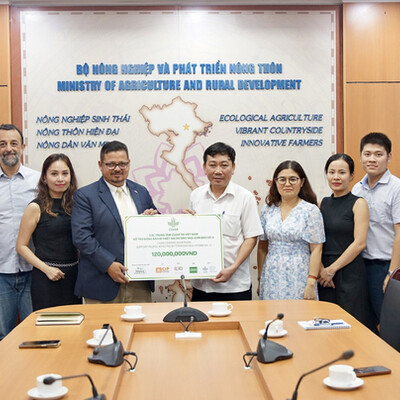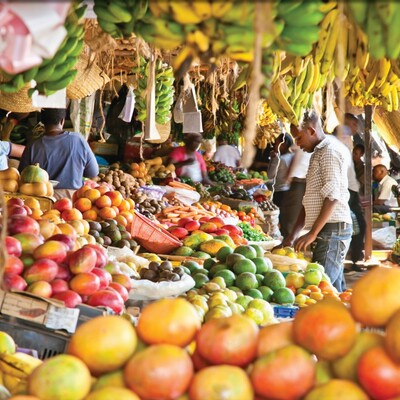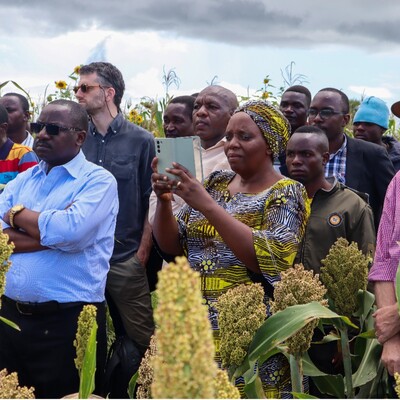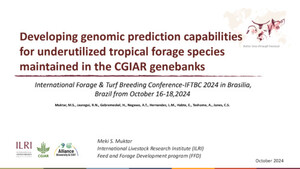
Sustainable livestock goes digital
Written by Shirley Tarawali

A workshop on ‘Sustainable livestock goes digital’ was held on 17 January at the GFFA 2019 (photo credit: BMEL/photothek.net).
On Thursday 17 January 2019, the Global Agenda for Sustainable Livestock (GASL), the Food and Agriculture Organization of the UN (FAO), the World Organisation for Animal Health (OIE) and the International Livestock Research Institute (ILRI) hosted a workshop on the theme of ‘Sustainable livestock goes digital’ at the 11th Global Forum for Food and Agriculture (GFFA) in Berlin.
The workshop served as a ‘bridge’ between the GFFA 2018, which focused on ‘Shaping the future of livestock – sustainably, responsibly, efficiently’ and the GFFA 2019 focus on ‘Agriculture goes digital – smart solutions for future farming’. It also responded to a request included in the ministerial communique issued at GFFA 2018 for FAO, OIE, ILRI and GASL to work together and report back.
The event used the four themes highlighted at GFFA 2018 as the organizing framework: Food and nutrition security, animal health and welfare, livelihoods and economic growth, and climate and natural resource use.
Henning Steinfeld (FAO) gave the workshop’s keynote presentation. He specified the key challenges for each of the four themes and identified some opportunities for digitally-based solutions. Panel interventions followed, interspersed with comments from young farmer delegates. The event concluded with audience engagement and discussion. Each panellist tackled one theme and highlighted the challenges, results and opportunities required to take solutions to scale. The young farmer delegates, who hailed from diverse backgrounds (Denis Kabiito from Uganda, Agustina Diaz Valdez from Argentina, Sarah Crofoot from New Zealand and Brian Rushe from Ireland), spoke about how to bring these proposed solutions to the challenges they perceived on the ground.
Steinfeld concluded his keynote presentation with five observations:
- There are great opportunities for digitalization to contribute to sustainable livestock systems
- Digitalization can help maximize opportunities and minimize risks
- The ‘digital divide’ refers to asymmetric access to technology: potentially disadvantaging smaller-scale producers
- To be adoptable by smaller-scale producers these technologies must be simple, robust and accessible
- Digitalization can be both enabling and disruptive.
Several other senior scientists at the workshop provided examples of the challenges and opportunities presented by digitalization. Dieter Schillinger (ILRI), discussed how the application of mobile phone-based approaches combined with high-end genomics is enabling better identification and deployment of improved dairy animals in Ethiopia and Tanzania. The approach is leading to improved productivity and thus contributing to increased incomes. Farmers have responded positively and readily contribute information because they receive real-time feedback that helps in their day-to-day herd management.
Fritz Schneider (GASL) spoke about applying approaches based on artificial intelligence to improve crop-livestock productivity and using blockchain to tackle food waste. Deploying a multi-stakeholder approach is key, he said, to effectively taking such solutions to scale and thereby improving food and nutritional security. Jean-Philippe Dop (OIE) focused on animal health and welfare. He observed that online tools allowing accurate and real-time monitoring of livestock diseases and antimicrobial resistance challenges are rapidly becoming the new normal and show great potential for improving animal welfare.
The discussions that ensued among the farmer delegates and audience members highlighted the challenges that remain if digitalization is to deliver on its promise for a sustainable livestock sector:
- Being smart about the data that is collected—and not collecting data without a purpose
- Being smart about the applications that are used – matching the tools to the job in hand and with the end user in mind. Is the information for the farmer, the producer, the consumer or the market trader?
- Recognizing the need for a two-way flow of information. Gathering data with no useful feedback to the providers is unsustainable.
- Realizing opportunities to integrate data from different sources.
- Issues of data transparency and ownership need to be clearly articulated and addressed.
This workshop was among the first sessions of GFFA 2019 and it was striking to note that almost every other discussion, whether a high-level panel, kick-off event or expert panel touched on similar issues.
This workshop highlighted three key messages:
- To meet the future demand for animal-based food to feed the growing human world population, all livestock systems have to become more sustainable and more efficient. Digital technologies will be important tools to achieve these goals.
- The Sustainable Development Goals of the UN Agenda 2030 (the SDGs) are the accepted reference frame for the sustainable development of the livestock sector. For all stakeholders, the critical issues are related to food security and nutrition; livelihoods and economic growth; animal health and animal welfare; and climate change and natural resources.
- To meet the present and the future challenges in the livestock sector, a coordinated approach among all stakeholders will be key. The Global Agenda for Sustainable Livestock (GASL) offers an ideal platform for multi-stakeholder action.
Download Henning Steinfeld’s keynote presentation
Read the OIE press release from GFFA 2019.
Download event flyer and see photos from the ‘Sustainable livestock goes digital’ workshop.
Read ILRI news blog articles on the GFFA 2018.
















